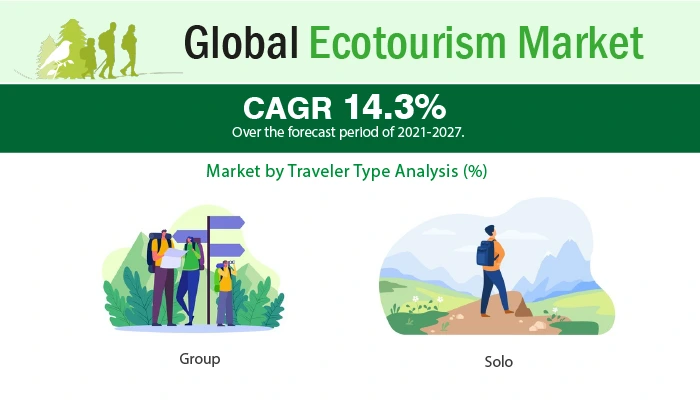Ecotourism Market (Traveler Type - Solo, and Group; Age Group - Generation X, Generation Y, and Generation Z; Sales Channel - Travel Agents, and Direct): Global Industry Analysis, Trends, Size, Share and Forecasts to 2027
A recent report published by
Infinium Global Research on the ecotourism market provides an in-depth analysis of
segments and sub-segments in the global as well as regional ecotourism market.
The study also highlights the impact of drivers, restraints, and macro
indicators on the global and regional ecotourism market over the short term as
well as long term. The report is a comprehensive presentation of trends,
forecast, and dollar values of the global ecotourism market. According to the
report, the global ecotourism market is projected to grow at a CAGR of 14.3%
over the forecast period of 2021-2027, growing from more than USD 229 billion
in 2021 to about USD 510.4 billion in 2027.

Market Insight
The travel and tourism sector has
evolved over the past few years with the changing demand and preferences of the
tourists. Depending on the travelers’ requirements, they chose different
destinations and different traveling plans. Ecotourism is a part of the travel
and tourism sector, where travelers visit destinations closer to nature, and
wildlife. Ecotourism also involves the concept of sustainable travel, where the
traveler’s emphasis is on conserving the natural ecosystem of the destination.
The biodiversity such as the flora and fauna, and the cultural heritage sites
are the center of attraction in ecotourism. Ecotourism also includes several
adventure activities such as mountain climbing, river rafting, and scuba
diving. Moreover, the market for ecotourism is fragmented with the presence of
several local travel agencies, and touring firms. Furthermore, several
ecotourism agencies collaborate with travel companies, and government
organizations to promote the destinations and their services. Such strategies
are anticipated to boost the ecotourism market.
The concern over the outbreak of
novel coronavirus affected the market growth of ecotourism over a short period.
As COVID-19 spread across the world, governments of several countries executed
strict restrictions as a control measure. These restrictions included in-bound
and out-bound travel bans. This, in turn, hampered the travel and tourism
sector across the world. Moreover, several ecotourism destinations such as
national parks, forests, and beaches were closed during the pandemic to control
the spread of infection. Furthermore, many tourists were hesitant to travel
over the concern of contracting the infection and chose to stay at their homes.
In addition, many ecotourism events were either postponed or canceled during
the pandemic period. This, in turn, reduced the number of tourists visiting
certain destinations. However, as the COVID-19 cases drop across various travel
destinations, the ecotourism market bounced back to its pre-pandemic state.
The growing awareness regarding
environmental conservation among the population is majorly driving the
ecotourism market. Ecotourism promotes the conservation of the environment
through touring through the ecosystem and understanding how it works. The
tourists experience nature and are encouraged to maintain its beauty. Moreover,
several eco-friendly tourist accommodations are established across remote
locations such as forests, and mountains. These eco-friendly accommodations
attract tourists to the sites. This, in turn, boosts the market for ecotourism
across the world. In addition, increasing penetration of social media supports
the ecotourism market. The pictures and videos of certain destinations uploaded
on social media attract travelers. This encourages potential travelers to visit
the destinations. However, poor infrastructure in these sites is a major
restraining factor for market growth. Nevertheless, the growing initiative by
the governments and travel agencies to promote the destinations is anticipated
to boost the market over the forecast period.
In terms of region, the global
ecotourism market is segmented into North America, Europe, Asia-Pacific, and
the Rest of the World. The Asia-Pacific region accounted for the highest
revenue in the global ecotourism market. Domination of Asia-Pacific was mainly
due to the presence of several naturally pristine destinations. Moreover, a
large number of travelers are aware of ecotourism in Asia-Pacific. Furthermore,
the presence of leading ecotourism agencies in Asia-Pacific further augments
the market growth in the region. On the other hand, the North America region is
anticipated to grow with the fastest growth rate over the forecast period. The
growth in North America is attributed to the growing awareness regarding
natural sites in the region. In addition, growing promotion activities by the
local governments to spread awareness regarding the local ecosystem attract
more tourists. This, in turn, further augments the ecotourism market in the
region.
Segment Covered
The report on the global ecotourism
market covers segments such as traveler type, age group, and sales channel. On
the basis of traveler type, the sub-markets include solo, and group. On the
basis of age group, the sub-markets include generation x, generation y, and
generation z. On the basis of sales channel, the sub-markets include travel
agents, and direct.
Companies Profiled:
The report provides profiles of
the companies in the market such as Adventure Alternative Ltd., Aracari Travel,
Travel Leaders Group, Expedia Group, FROSCH International Travel, Inc.,
Intrepid Group Limited, BCD Group, G Adventures, JTB Americas, Ltd., and
SARL Undiscovered Mountains France.
Report Highlights:
The report provides deep insights
into the demand forecasts, market trends, and micro and macro indicators. In
addition, this report provides insights into the factors that are driving and
restraining the growth in this market. Moreover, The IGR-Growth Matrix analysis
given in the report brings an insight into the investment areas that existing
or new market players can consider. The report provides insights into the
market using analytical tools such as Porter's five forces analysis and DRO
analysis of the ecotourism market. Moreover, the study highlights current market
trends and provides forecast from 2021-2027. We also have highlighted future
trends in the market that will affect the demand during the forecast period.
Moreover, the competitive analysis given in each regional market brings an
insight into the market share of the leading players.
